Evolution can lead to the emergence of new species and the extinction of old ones. It also drives the ongoing adaption of all species so that the lines between on species and the next are often blurry. Those species that fail to adapt, fail to survive and go extinct. The extinction of certain species may be man-made or natural. In the distant past, extinction was a natural event. With the rise of humanity, a great number of species have gone extinct or face extinction because we have driven them to it. Our world is currently facing a man-made extinction event unlike anything our planet has ever seen before.
Previous extinction events are evidenced in our history and the fossil record. An extinction level event is a natural path to extinction but on a massive scale. In the last 500 million years, there have already been six extinction-level events.
Below are the six extinction events that have already happened on our planet:
1. The Ordovician to Silurian Extinction
Significant changes in the environment happened during the Ordovician period. This took place 485-444 million years ago. There was a bloom in species diversity, but a massive extinction event happened near the end of the period. Extreme glaciation locked up large bodies of water. The formed ice cap covered a big land area in the south pole.
Scientists believe that the emergence of the Appalachian Mountains triggered the glaciation. The weathering of these huge rocks took much of the carbon dioxide from the atmosphere. This cooled the Earth drastically.
The sea levels lowered to the point where animals in the shallows lost their homes. This was a major crisis among the living organisms. When the sea levels rose again, levels of oxygen in the water dropped. This resulted in toxic ocean waters.
This extinction-level event wiped out 85% of living organisms on Earth. It killed most marine life, including trilobites, corals, brachiopods, and conodonts. Below are two of the well-known Ordovician animals that suffered during this event:
Conodonts
The discovery of conodont microfossils only occurred 150 years ago. Since then, paleontologists have been hunting for good specimens. In 1983, fossilized conodonts were discovered on Scotland’s 330 million-year-old rocks. There are only 12 microfossils of conodonts in the world. The squiggles in the fossils show the entire body of the conodont.
The fossils show traces of their eyes, muscles, and the absence of bones. Fossilized conodonts show that they were a few centimeters long, with a stiff backbone and eel-like features. A conodont had eyes and a finned tail. These primitive vertebrates had teeth as well. Scientists suggest that these creatures hunted their food.
Trilobites
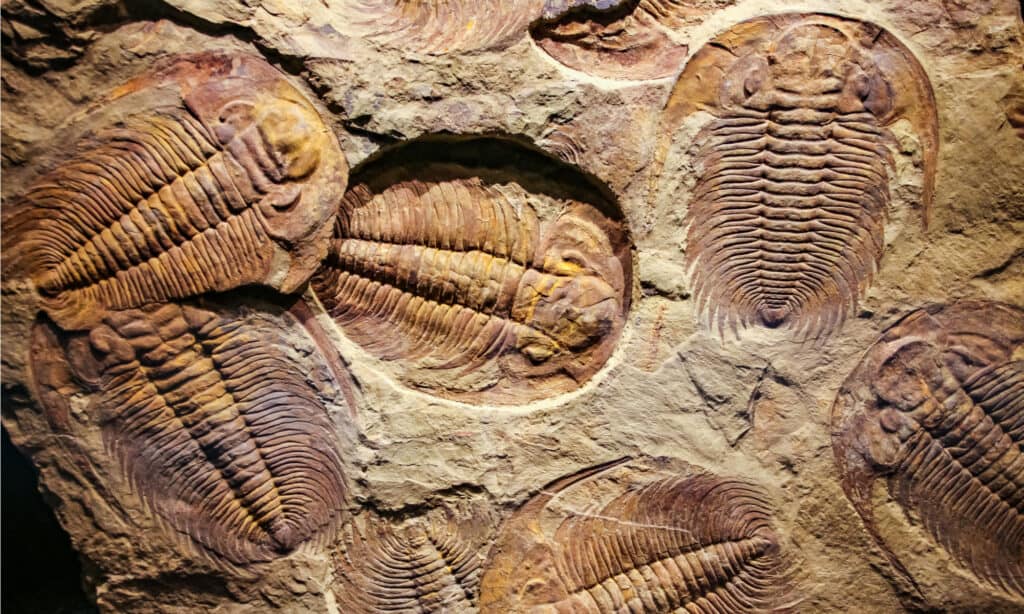
©Merlin74/Shutterstock.com
These extinct arthropods are well-known for their defined skeletal remains in their fossils. Scientists believe that these primitive animals rolled up into a ball. They did this to protect themselves. Trilobite fossils are rare. Most of them were scavenged by sea creatures or scattered by the waves. These organisms grew by shedding their exoskeleton many times. Suture lines in the head split to help release the old exoskeleton.
Trilobites may have consumed soft animals or filtered food particles from the ocean floor. Research shows that all trilobites lived in the ocean. They also burrowed into the mud and sand of the ocean floor. Evidence shows that these creatures swam just above the bottom of the ocean.
2. The Devonian Extinction
About 383-359 million years ago, 75% of the Earth’s species were wiped out. Many pulses occurred throughout the Devonian period. These lowered the levels of oxygen in the oceans. This led to the elimination of the primitive sea sponges and goniatites (shelled, soft-bodied relatives of octopuses and squids). The occurrence of pulses is known as the Kellwasser event.
Rock weathering increased as well because of the growth of huge plants. This event poured land nutrients into the oceans. This led to algae growth. Dead algae then sucked out the oxygen from the waters. The drastic growth and spread of huge trees took out the carbon dioxide in the atmosphere, and this led to global cooling.
The diversity of species slowed down significantly during this period as well. Species from around the world mingled, which led to the homogenization of the ecosystems. Below is a group of animals that went extinct during this time:
Graptolites
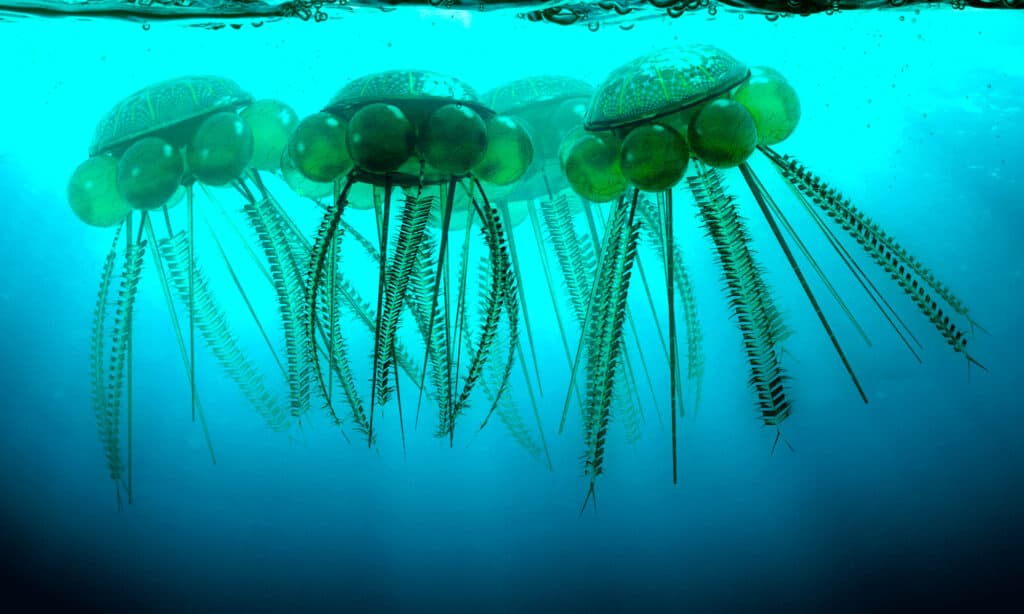
©Aunt Spray/Shutterstock.com
These are minute animals that lived together in colonies. They shared the same skeleton, which served as a habitat. The skeleton was made of chambers, some of which grew like tree branches. Scientists believe that these organisms were suspension feeders. They strained pieces of food or plankton that floated in the water.
Research shows that graptolites lived on the ocean floor. They grew upwards as they added new living chambers to the colony. Other graptolites floated in the water. These colonies might have drifted with the waves.
3. The Permian to Triassic Extinction
There was a terrible cataclysm that happened about 252 million years ago. The Permian-Triassic extinction-level event was also called the Great Dying. Here, about 96% of all marine organisms died off. Every forest was destroyed. Large populations were killed as well. Plants took 10 million years to grow back. It took four to eight million years for marine life to recover.
The Siberian Traps erupted at this time. This released magma to the surface. Methane and other greenhouse gases filled the atmosphere. The Earth heated up, rocks weathered, and acid rain poured. Oxygen in the oceans was depleted by 76%. Many animals died off. Here are a couple of animals that suffered during this event:
Arctops
These animals looked like bears. They lived on southern African plains. Arctops weighed 100 pounds with a length of six feet. They were meat-eaters with snouts like that of a crocodile and long legs.
Biarmosuchus
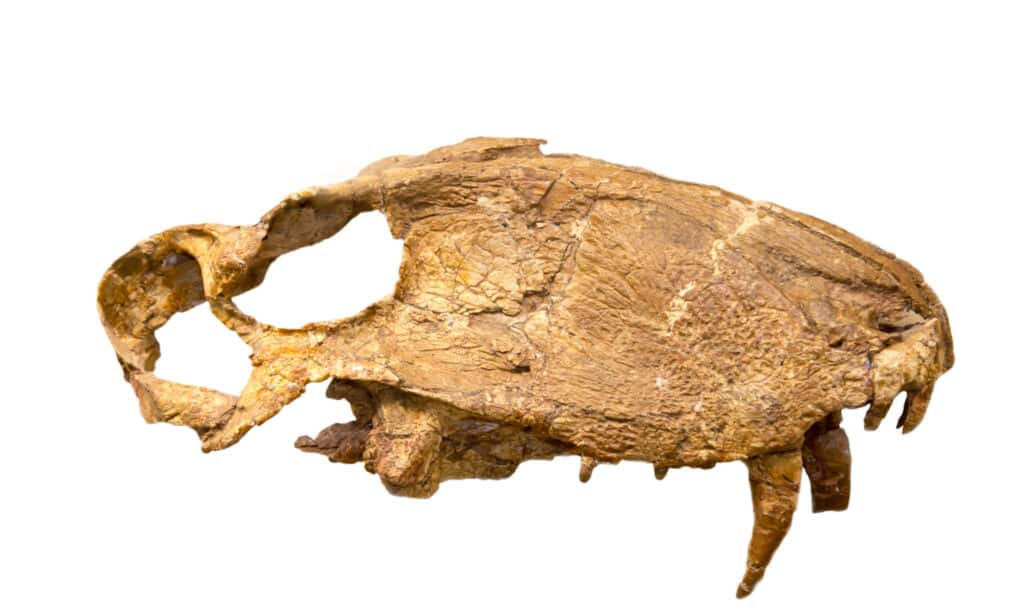
©Victor1153/Shutterstock.com
These creatures were like crocodiles. They live in central Asian woodlands. They were about 50 pounds in weight and four feet in length. The head of these meat-eaters was large, and their legs were slender.
4. The Triassic to Jurassic Extinction
It took a very long time for the Earth to recover from the Great Dying period. Once life was back on track, species diversified right away. Reef builders started to work and thrive. Vegetation started to spread all over the land.
This rapid growth set the Earth for the archosaurs. These early dinosaurs are the ancestors of crocodiles, birds, non-avian dinosaurs, and pterosaurs. Then, another extinction-level event happened. It wiped out 80% of all marine and land organisms because of the volcanic eruptions, climate changes, and asteroid impact. It also broke up the supercontinent called Pangaea. The following are the animals that went extinct during this time of extinction:
Nothosaurs
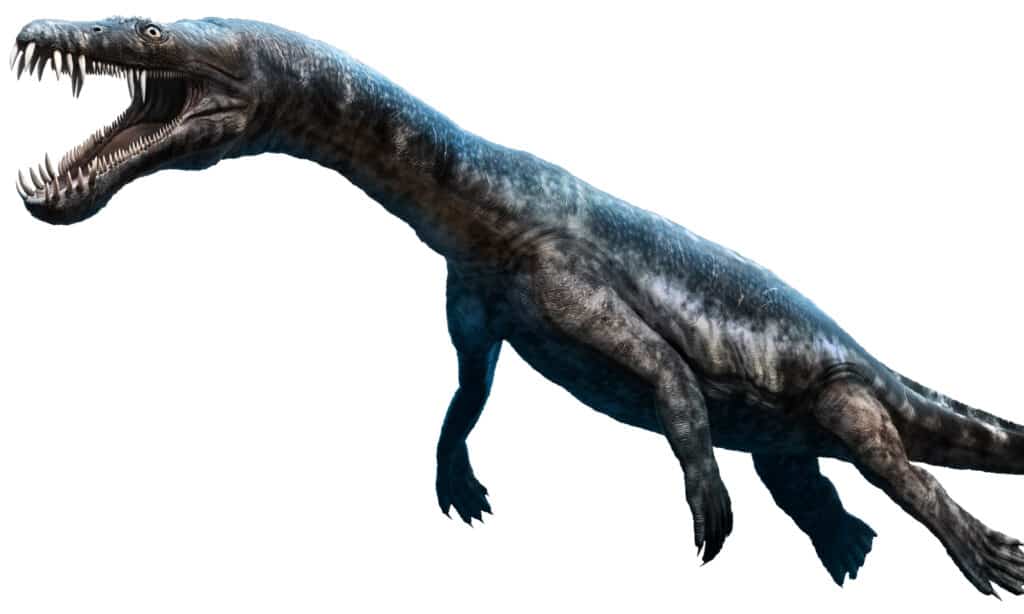
©Warpaint/Shutterstock.com
These were marine reptiles that thrived during the Triassic period and died off by its end. True Nothosaurs were about three meters long. Pachypluerosaurs were primitive and small. Nothosaurs had paddle-like feet. Scientists also believe that their feet were webbed. They had flat, lengthened heads and long necks. They also had sharp, protruding teeth. Research shows that these creatures lived like seals. They hunted in water and stayed along shores.
Tyrannosaurus rex
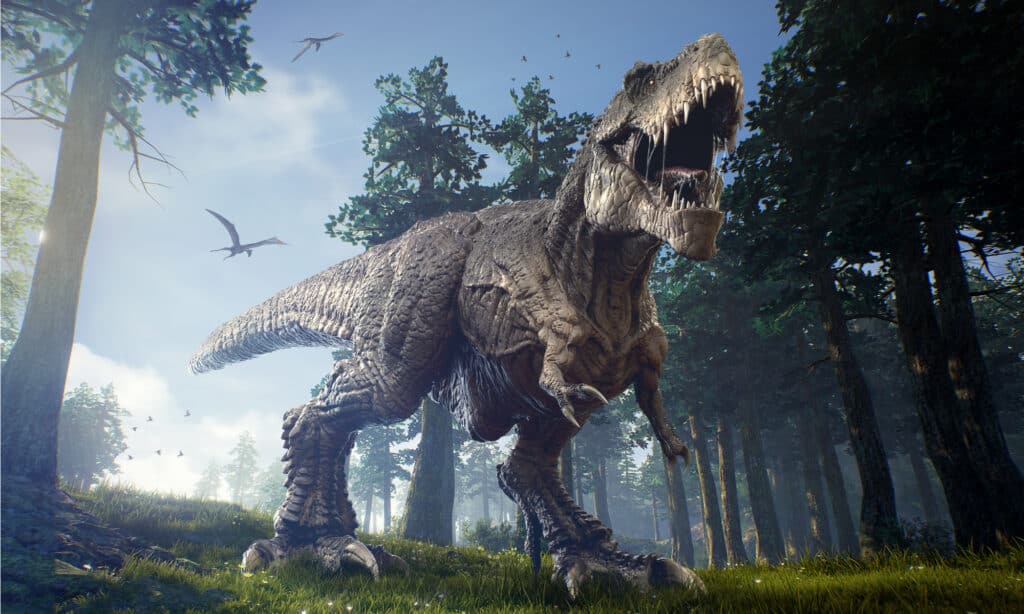
©Herschel Hoffmeyer/Shutterstock.com
The name simply means King of the Tyrant Lizards. This dinosaur evolved to dominate. Its body was muscular and could grow up to 40 feet. It was the size of a bus, about eight tons.
Scientists say that these dinosaurs scavenged carcasses and ate living animals. There were also instances when they ate one another. A T-Rex’s mouth crunched through bone. It had a keen sense of smell, which helped it detect prey, mates, and other predators.
5. The Cretaceous to Paleogene Extinction
This extinction-level event happened about 66 million years ago. It is the latest extinction event, and it is the only one connected to a huge asteroid impact. After this event, 76% of the Earth’s organisms died off, including the non-avian dinosaurs.
An extremely large asteroid hit the planet. Massive volumes of sulfur, dust, and debris went into the atmosphere. This resulted in global cooling. Wildfires started upon the great impact. A tsunami formed as well. The non-avian dinosaurs and their ecosystems started to deteriorate overnight. Here is an animal that became extinct during this destructive event:
Iberomesornis
Its name means Spanish intermediate bird. This animal’s diet was uncertain. The Iberomesornis is one of the ancestors of the modern bird. The very first bird-like dinosaur was the Archeopteryx, which had a long tail. Iberomesornis did not have a long tail. Instead, it had a pygostyle for its tail flight feathers. It looked more like modern birds. It only had one wing claw. Its feet were built for perching.
6. The Holocene Extinction
The Earth is going through the Holocene extinction. This event is not defined as a drastic event yet. It consists, instead, of many extinctions in the last 10,000 years as humans dominate the planet. The Holocene extinction is also known as the Anthropocene Extinction. Humans continue to contribute to this event. Below are the recently extinct animals and the causes of their destruction:
Northern White Rhinoceros
These beautiful animals became extinct in the wild in 2018. The last of these animals are both females. That is why they are guarded by armed personnel at Ol Pejeta Conservancy in Kenya. The last of the males died in 2018.
Pyrenean Ibex
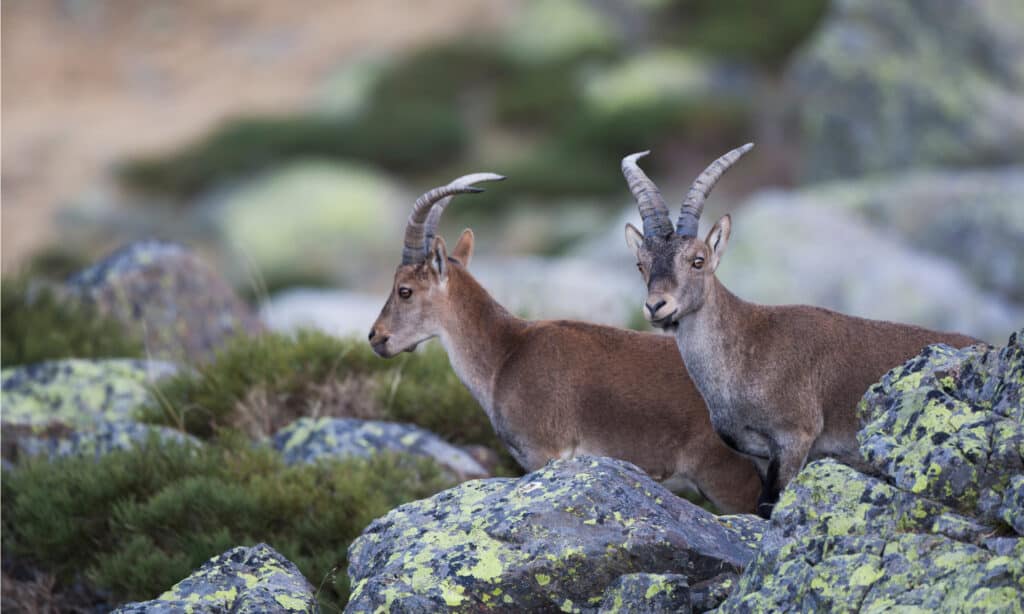
©Alexandre Boudet/Shutterstock.com
This is the subspecies of the Spanish Ibex. It is a native of the Pyrenees Mountains on the border of Spain and France. The Pyrenean Ibex was abundant during medieval times. The species became extinct in the wild in 2000 due to hunting and the inability to compete with the wild chamois or livestock for food.
Conclusion
Extinction-level events can wipe out different species. The drastic changes in climate and other environmental elements left ancient animals unable to adapt. Large animals were the first to die out. The same thing is happening in the current Holocene period. Man has a significant contribution to the extinction happening right now.
| Extinction Event | Time Period |
|---|---|
| 1. | The Ordovician to Silurian Extinction |
| 2. | The Devonian Extinction |
| 3. | The Permian to Triassic Extinction |
| 4. | The Triassic to Jurassic Extinction |
| 5. | The Cretaceous to Paleogene Extinction |
| 6. | The Holocene Extinction |
Up Next…
- Different Types Of Extinct Animals There is a huge variety of life on our planet. The species alive today are just a portion of those that have come before. Learn more about them here.
- Gigantopithecus: The Giant Extinct Orangutan You’ve heard of all sorts of dinosaurs but did you know there was a giant Orangutan? Click here to find out.
- Extinct In The Wild Animals Some animals have become extinct in the wild, but are still clinging to existence in zoos an preserves. Find out more about these animals here.
The photo featured at the top of this post is © Orla/Shutterstock.com
Thank you for reading! Have some feedback for us? Contact the AZ Animals editorial team.






